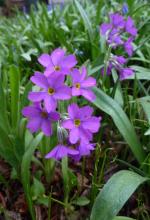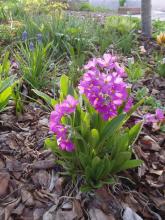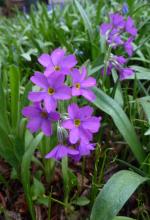So, my Primula rusbyi, which formerly seemed surprisingly happy despite the dry conditions, have failed to bloom for the last couple of seasons. John Richards, in Primula, notes that the species is "(i)nitially free-flowering, but often languishing in a vegetative state when older". Hmm, sounds familiar - these plants are 8 or 9 years old.
Does anyone have any advice for divisions or possibly cuttings? As non-blooming primulas strike me as being a bit pointless, it seems there is little to lose now.
Thanks in advance.
Comments
Re: Primula rusbyi: help with, that is.
Hmmmmm...just realized that a number of my ellisiae/rusbyi didn't bloom last year either. I never made the connection.
These grow on rocky cliffs in NM and Arizona--and they usually bloom in May and June (which is often a dry period there)...but the cliffs usually have seepage and they do get the Monsoon in the summer. I think they don't like it all that dry.
And Westerners generally like more food than we realize: I shall make a point of feeding mine this year. I suspect they might divide all right, although when you consider they are closely related to Primula parryi which hates heat and drought and will not grow very long for us at all, we should be grateful we can grow them at all.
These southern primulas are really superb: I think one of the things we forget about garden plants is that much of what we grow in our gardens has been selected for long bloom and adaptability: these are but the first generation. We have yet to pick out the best garden performers. One day, many of our westerners will be represented by better blooming clones (and often superior color forms with larger flowers) that have been selected out in our gardens. This process has only just begun!
Re: Primula rusbyi: help with, that is.
So, I did get a few flowers this spring again from the leading edges of the old plants:
... and then I whacked them into 6 or 7 chunks and replanted them! We'll see if this brutal treatment injected some new life into them come spring!
Re: Primula rusbyi: help with, that is.
When I get the Primula seed list I know exactly what to look for!
Re: Primula rusbyi: help with, that is.
Hi Lori,
I'm waiting to hear about your results. And, of course, where in your garden you grow the P. rusbyi. In shade, part sun, full sun?
Peter
Re: Primula rusbyi: help with, that is.
Well, I can't say that I was suddenly inundated in bloom this year, unfortunately! One division did bloom but that was all. I have been growing these in part shade, in perennial beds that are shaded by apple, pear and birch trees; the beds have been getting quite dry around about now these past few years... as the trees have grown up, I suppose. Your question has made me realize that I really ought to stick a couple of the divisions in the tufa bed and see what happens there - it might provide a bit more natural environment, in fact (notwithstanding my inability to emulate any springs or seeps that might occur in its natural habitat).



When Pam Eveleigh came to speak on primula for our chapter, I wasn't able to go, but I read in a member's notes that this is not uncommon with certain species of the genus. If I remember correctly, divisions are a good coarse of action, and some preferring it every 3 years.
That plant has big flowers! Wonderful!